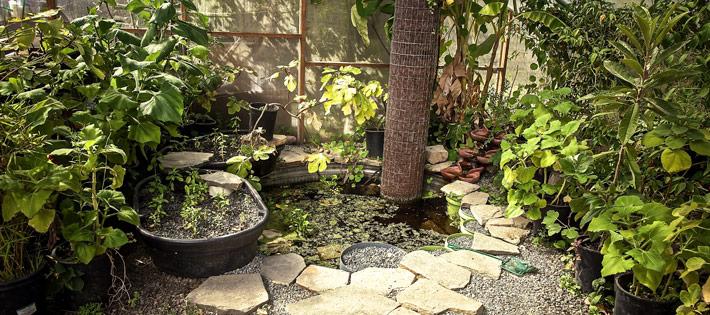What is Permaculture?
Permaculture is a design science rooted in the observation of natural systems. The principles of permaculture teach us how to design ways of living that have the stability and resiliency of natural systems. They show us positive solutions for creating and managing systems for food, medicine, water, shelter, and more.
Permaculture is a multi-disciplinary art form, drawing from the physical sciences, architecture, nutrition, the healing arts, traditional ecological knowledge (TEK), and spirituality. The ethical underpinnings that guide permaculture are simple yet powerful: take care of earth, take care of the people, and share the surplus.

Designing from nature is not a new concept — traditional people have practiced this design technique for thousands of years. In today’s world, where many of us have grown up in disconnection with nature and unaware of the deeply interwoven structures that create efficient, no-waste, closed loop ecological systems, permaculture provides a powerful framework for re-designing our lives. In fact, the principles of permaculture are exactly what we need to implement practical solutions to restore our damaged environments and bring the earth back into a thriving, healthy state of being.
You can apply permaculture to any setting or climate — your garden or farm, urban and suburban homes, community structures, watershed systems, and even to relationships and your own “inner ecology.” Applying the principles and ethics of permaculture can provide solutions on any scale — here are some examples:
Permaculture allows us to partner with nature to make long-lasting, regenerative systems that can heal the planet and ourselves for generations to come.
Where Did It Come From?
The idea of designing our lives based on natural systems is not new — our ancestors naturally embodied these concepts for centuries and indigenous cultures still do today. More recently, Bill Mollison and David Holmgren from Australia, developed the concept of permaculture in the 1970s and first taught permaculture as an applied design system in 1981. There was no term at the time for “sustainable culture,” so they coined the term "permaculture" to articulate the notion of "permanent agriculture." The term has evolved into the notion of "permanent culture," reflecting a broader definition including a more holistic spectrum of human needs.
How Does It Work?
Permaculture asks: how do we — as a human species — sustain ourselves and provide for our needs and the needs of the environment for an indefinite period of time? Permaculturists find practical solutions by using nature-inspired principles to create productive ecosystems that have the stability, diversity, and resilience of those found in the natural world.
For example, when creating (or re-designing) a home site, a permaculture designer looks for ways to integrate water catchment, existing buildings, and energy systems with tree crops, edible and useful perennials, self-seeding annuals, domestic and wild animals and aquaculture. In this scenario, excess or waste products from plants, animals and human activities are used as nutrients to benefit other elements in the system. Plantings are arranged in patterns that can catch water, filter toxins, absorb nutrients and sunlight and block the wind. Particular associations of trees, perennial vines, shrubs and ground covers known to nourish and protect one another are clustered together. Ponds and other elements are constructed in patterns that maximize their edges to take advantage of the increased biological activity at the intersection of two ecosystems.
Creating a permaculture environment is a gradual and long-range process. To implement a design, the permaculturist looks for the right timing and keeps the design flexible, so that changes can be made as observation of the land and the system, and experience, bring new understanding.
However, permaculturists also use "quick-start" techniques that result in maximum effect with minimum effort. For example, to start a successful garden in a weedy or compacted area, it can simply be covered with "sheet compost" — layers of newspapers, cardboard and straw. After a thorough watering, soil and seedlings can be inserted into holes in the cardboard. From that point, natural systems take over — the worms, bugs, fungus, microorganisms, and roots — and do the rest to help establish a fertile and healthy garden.
Over time, the practice of permaculture results in more than well-designed landscapes and integrated living systems. As we work within the principles of permaculture, permaculture begins to work within us! It is a tool of transformation, because as we actively participate in the closed-loop systems of nature, we reclaim an ancient circuitry within us that opens to a new world of possibilities.
How Do I Learn Permaculture?
The education system within the permaculture community, based on Mollison and Holmgren’s first course in the 1970s, is a 72-hour design class. The standard Permaculture Design Course (PDC) curriculum transcends cultural, religious, political and economic boundaries, though no two designs or trainings are exactly the same. Enrollment in a PDC is the best way to gain an understanding of the permaculture approach and the full scope of what it has to offer.
Today, tens of thousands of people around the planet have taken workshops and seminars, and hundreds of PDC courses are open for enrollment all over the globe. How do you choose what course is right for you? Here are some guidelines to help you get the most out of your permaculture education.
What are your outcome goals?
Permaculture is a broad spectrum — what are your individual goals for the course? For example, if you are really interested in learning more about natural building and grey water systems, find a course that includes curriculum, observation, and participation in those areas. If your goal is to transform your home garden into a permaculture food forest, take a course in the same climate as your home so you transfer what you learn about plants directly into your own yard.
Where is the class located?
Classes are located over the globe, from beautiful tropical islands to college classrooms. Find out how long the site has been developed under the principles of permaculture, and what features you can expect to observe and learn from.
What is your learning style?
Every PDC is a blend of lecture and hands-on activities, although the ratio varies widely from course to course. Find a course that has a ratio that is a good match for your needs. Also, pay attention to the format of the class and how that suits your learning style — some course are offered in two week intensives, and other are spread out over a period of six months to a year.
Who are the instructors?
There is not a formal certification process for those teaching permaculture – as a student, you determine whether or not the instructors are a good fit for you. Read biographies, make note of how long they have been teaching and working in permaculture, and learn about their areas of unique expertise they will bring to the course.
In addition to taking a PDC, here is a list of recommended readings we find useful for those who want to learn more.
Beyond the PDC
After you take a PDC, you are awarded a certificate in permaculture, signifying that you are the holder of a profound toolbox of solutions and visions! Immediately, this distinguishes you from other people who understand permaculture as simply a technique for growing food. As a graduate of a PDC, you can communicate to others the full scope of what permaculture design has to offer, and begin applying it to your own life and career. When you hold a certificate in permaculture, others will recognize you as having a holistic understanding of what integrated, regenerative living systems can be.
Students who have completed the globally recognized 72+ hour Permaculture Design Certification course (PDC) can advertise that they are a certified permaculturist and can use the word permaculture in their work. We recommend that graduates spends two years applying what they learn in the permaculture course before they work professionally, especially if they did not have much prior experience. Other professionals who’ve come into a PDC with a lot of relevant experience can begin working in permaculture as soon as they graduate.
Many of our students who are not seeking a career in permaculture find that taking our PDC enables them to apply permaculture principles to their existing profession and their personal life. They don’t necessarily advertise themselves a “permaculturist,” but the knowledge and perspective they gained in the PDC gives them more creativity and success in their lives.












